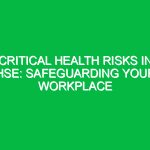Introduction
Hello team, and welcome to today’s toolbox talk. Today, we’re diving into a crucial topic that affects each and every one of us: “Why We All Should Care” about our Health, Safety, and Environment (HSE) initiatives. Understanding the importance of HSE isn’t just about compliance; it’s about creating a safe workplace where we can all thrive. As we prepare to start our work today, let’s take a moment to reflect on how our actions impact our Safety and the environment around us.
The Importance of HSE
Health, Safety, and Environment policies are designed to protect us from workplace Hazards. They set the Standards for how we operate, ensuring that we minimize risks and create a safe working environment. But why should you care? The answer is simple: your Safety and well-being depend on it.
- Personal Responsibility: Every employee has a role in maintaining a safe workplace. When we all take responsibility for our own safety, we contribute to the overall safety of our team.
- Legal Compliance: Following HSE Regulations isn’t just good practice; it’s the law. Violations can lead to fines, penalties, and even legal action.
- Preventing Accidents: By understanding and adhering to HSE protocols, we reduce the risk of accidents and injuries.
- Boosting Morale: A safe working environment leads to higher job satisfaction and better productivity.
Understanding Why We All Should Care
So, what do we mean when we say “Why We All Should Care”? It encapsulates the idea that every individual’s actions contribute to the safety culture of our workplace. Let’s break this down into key components:
1. Individual Impact
Your actions directly influence your safety and the safety of your coworkers. For example, if you notice a spill and choose not to report it, you’re putting others at risk. Conversely, if you take the time to clean it up or inform someone who can, you’re actively contributing to a safer environment.
2. Teamwork and Communication
Safety is a collective effort. Regular toolbox talks foster open communication, allowing team members to share concerns and suggestions. When everyone is engaged, we build a culture of safety and accountability.
3. Continuous Improvement
The world of HSE is always evolving. New technologies and methods emerge, and regulations change. By caring about HSE, we commit to continuous learning and improvement, ensuring that we stay ahead of potential Hazards.
Real-Life Examples and Scenarios
Let’s consider a scenario: imagine you’re on a construction site, and you see a colleague working without their Personal Protective Equipment (PPE). What do you do? Ignoring the situation could lead to serious injury. Instead, you should speak up and remind them of the importance of wearing PPE. This simple action not only protects your colleague but also reinforces the safety culture we are trying to build within our team.
Anecdote: The Importance of Reporting
In a previous workplace, an employee noticed that a machine was making unusual noises. Instead of reporting it, they assumed it was nothing serious. Unfortunately, the machine malfunctioned, leading to a significant injury. This incident highlighted the critical importance of reporting even minor concerns. If the employee had cared enough to speak up, the accident could have been prevented.
Best Practices for HSE Compliance
Now that we’ve established why we should care, let’s discuss some practical steps you can take to promote HSE in your daily operations:
- Be Vigilant: Always be aware of your surroundings. Report hazards immediately.
- Participate in Training: Attend all HSE training sessions and Toolbox Talks. Engage actively and ask questions.
- Use PPE: Never underestimate the importance of Personal Protective Equipment. Always wear it as required.
- Communicate: Share your concerns and observations with your team. Effective communication is vital in preventing accidents.
- Lead by Example: Set a positive example for others. Your commitment to safety can inspire your colleagues to take HSE seriously.
Potential Hazards and Risks
Understanding the hazards associated with our work is crucial. Here are some common risks that we might encounter:
- Slips, Trips, and Falls: These are among the most common workplace accidents. Always keep walkways clear and report any hazards.
- Equipment Malfunction: Regularly inspect tools and machinery. Report any issues immediately.
- Exposure to Harmful Substances: Be aware of any hazardous materials you may encounter. Always follow safety data sheets (SDS) and use appropriate PPE.
- Ergonomic Risks: Understand the importance of proper lifting techniques and workstation setup to prevent strain injuries.
Regulations and Standards
Compliance with HSE regulations is not merely a suggestion; it’s a requirement. Familiarize yourself with relevant regulations such as:
- Occupational Safety and Health Administration (OSHA) Standards: These set the legal requirements for Workplace Safety.
- Environmental Protection Agency (EPA) Regulations: These focus on protecting the environment from harmful workplace practices.
- Company Policies: Always adhere to your company’s specific safety policies and Procedures.
Understanding these regulations is essential, as failure to comply can result in severe consequences, including fines, legal action, and increased risk of accidents.
Conclusion
In conclusion, caring about health, safety, and the environment is not just an obligation; it’s a commitment we make to ourselves and our coworkers. Each of us plays a vital role in ensuring a safe workplace. By adhering to HSE practices, participating in toolbox talks, and communicating openly, we foster a culture of safety that Benefits everyone.
As we finish today’s talk, I encourage you to reflect on how you can apply these principles in your daily work. Thank you all for your attention and for your commitment to making our workplace safer. Remember, when it comes to safety, we all should care!


